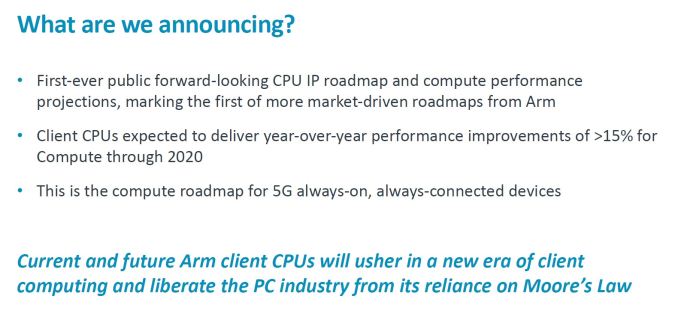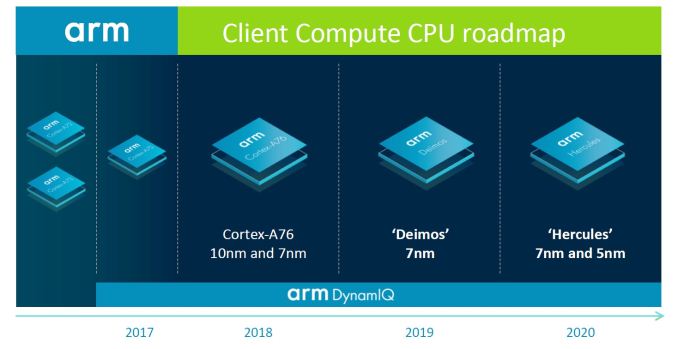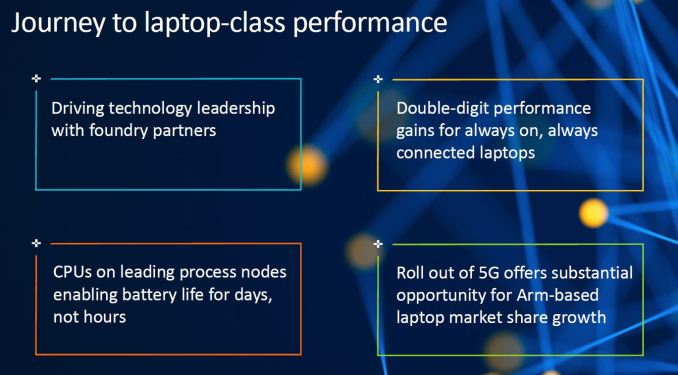Arm Unveils Client CPU Performance Roadmap Through 2020 - Taking Intel Head On
by Andrei Frumusanu on August 16, 2018 9:05 AM EST
Today’s announcement is an oddball one for Arm as we see the first-ever public forward looking CPU IP roadmap detailing performance and power projections for the next two generations through to 2020.
Back in May we extensively covered Arm’s next generation Cortex A76 CPU IP and how it’s meant to be a game-changer in terms of providing one of the biggest generational performance jumps in the company’s recent history. The narrative in particular focused on how the A76 now brought real competition and viable alternatives to the x86 market and in particular how it would be able to offer performance equivalent to Intel’s best mobile offerings, at much lower power.
Arm sees always-connected devices with 5G connectivity as a prime opportunity for a shift in the laptop market. Qualcomm’s recent Snapdragon 835 and Snapdragon 850 platforms were the first attempts in trying to establish this new slice for Arm-based PCs.
Today’s roadmap now publicly discloses the codenames of the next two generations of CPU cores following the A76 – Deimos and Hercules. Both future cores are based on the new A76 micro-architecture and will introduce respective evolutionary refinements and incremental updates for the Austin cores.
The A76 being a 2018 product – and we should be hearing more on the first commercial devices on 7nm towards the end of the year and coming months, Deimos is its 2019 successor aiming at more wide-spread 7nm adoption. Hercules is said to be the next iteration of the microarchitecture for 2020 products and the first 5nm implementations. This is as far as Arm is willing to project in the future for today’s disclosure, as the Sophia team is working on the next big microarchitecture push, which I suspect will be the successor to Hercules in 2021.
Part of today’s announcement is Arm’s reiteration of the performance and power goals of the A76 against competing platforms from Intel. The measurement metric today was the performance of a SPECint2006 Speed run under Linux while complied under GCC7. The power metrics represent the whole SoC “TDP”, meaning CPU, interconnect and memory controllers – essentially the active platform power much in a similar way we’ve been representing smartphone mobile power in recent mobile deep-dive articles.
Here a Cortex A76 based system running at up to 3GHz is said to match the single-thread performance of an Intel Core i5-7300U running at its maximum 3.5GHz turbo operating speed, all while doing it within a TDP of less than 5W, versus “15W” for the Intel system. I’m not too happy with the power presentation done here by Arm as we kind of have an apples-and-oranges comparison; the Arm estimates here are meant to represent actual power consumption under the single-threaded SPEC workload while the Intel figures are the official TDP figures of the SKU – which obviously don’t directly apply to this scenario.
We didn’t have internal data to verify Arm’s claims as of publishing of the article, but the 15W Intel figure is naturally on the high side, given that this just the official TDP representing multi-threaded workloads – a very quick test of CB15 ST power as reported by MSR registers on an 7200U at 3.1GHz measured 9.3W package+DRAM power while an 8250U at 3.35GHz came in at 11W. I haven’t correlated SPEC power on x86 to date, but I’m expecting it on average to be less than CB15. Even if the 15W figure for the 7300U is correct, and I’m expecting something more in the range of 9-11W, Arm might be using one of Intel’s notably less efficient performance points when doing the comparison for these SKUs. Of course this doesn’t invalidate the data as efficiency for the A76 at those frequencies would also not be optimal, it’s just something to keep in mind.
It’s also interesting to see Arm scale back on the performance comparison as they’re using a 3GHz A76 as the comparison data-point – this is in contrast to the 3.3GHz maximum 5W performance point presented during TechDay. I had tried to estimate the A76’s power in mobile form-factors based on the different metrics Arm disclosed and came at an estimated 2.3W at 3GHz. Naturally Arm says “less than 5W” and they could be erring on the safe side of not over-promising – but if it had been *that* much lower, as in my estimate, we would have maybe seen even more aggressive marketing figures. In the end, until we get the first A76 devices in our hands, we won’t know for sure what the exact figures will be and at which point on the efficiency curve Arm’s projected 3GHz performance figures will end up at.
The last slide that is notable to talk about is the performance projections for Deimos and Hercules. Here Arm’s taking a direct stab at Intel’s lack of significant progress over the last few years and reiterating its confidence in the company’s ability in sustaining high CAGR (compound annual growth rate) performance figures for the next generations.
Again at TechDay we quoted figures of 20-25% while today’s announcement contained a more conservative figures of “>=15%” – likely better representing a seemingly larger 20% projected boost for Deimos as well as what seems to be a 10% gain for the 5nm follow-up Hercules. Taking into account the relative positioning of the data-points in this chart, I did some quick correlation and it matches my initial estimated performance figures for a 3GHz A76 at around ~26 SPECint2006. Deimos and Hercules would come in at figures of ~31 and ~34 points.
Finally today’s announcement is a marketing exercise attempting to emphasise Arm’s performance and power commitments over the next few generations, trying to showcase it has the strategy and technology in place to make the Arm laptop market a real growth opportunity. If and how this pans out is something that we won’t find out at least until later on in the year, with the first actual A76 based large form-factor designs not being a thing until at least sometime in 2019. We’re eagerly awaiting the first A76 based mobile designs in the months to come and to have a first hand-on evaluation of the new microarchitecture family.















102 Comments
View All Comments
UpSpin - Thursday, August 16, 2018 - link
I haven't linked to any Synology article and I only see that QNAP releases new NAS with new ARM SoCs.And by manually setting the display brightness one doesn't deactivate the CPU power management and most people don't know how to do this either. Contrary, I see a lot of people with dark screens to prolong battery life.
whataboutpereira - Friday, August 17, 2018 - link
I see a lot of people with dark screens who don't know how to change the brightness back to normal. :)close - Friday, August 17, 2018 - link
@whataboutpereira, power consumption for plugged in devices like a NAS means nothing to most people. 4W? 5W? 10W? All the same in most people's books. Especially when electricity is cheap enough that it will never offset the extra money you pay for the more efficient device.BurntMyBacon - Friday, August 17, 2018 - link
I agree with your original statement that QNAP releases more new NAS boxes based on ARM than x86. It makes sense given the efficiency for a compute-lite device. On the other hand, they have within the past year release new NAS boxes based on x86, presumably with a more compute heavy focus in mind. One example:https://www.qnap.com/en/news/2017/world-s-first-ry...
Manch - Thursday, August 16, 2018 - link
Fair enough, it's close, but its also lacking feature wise compared to x86. x86 is still very much relevant in NAS. Especially when it comes to transcoding and heavy lifting. Don't get me wrong, I think ARM procs are great for certain things, but I don't see Intel sitting still. They have competition from AMD as well. They can no longer rest on their laurels. As far as a x86/ARM feature compare and perf/power goes, I still think NAS is a poor choice to compare in this regard. ARM has the low power usages but x86 has the the power to provide a much more expanded feature set. Plus isn't ARM limited to EXT 4?Kvaern1 - Thursday, August 16, 2018 - link
I'd also think you'd want somewhat more horsepower for transcoding than appropriate Arm chips currently deliver.xurxoham - Friday, August 17, 2018 - link
I don't know what you mean by compute power, but in the highest end products, Intel is clearly not unbeatable any more.In the ARM world, you got some companies like Cavium, HPE, Fujitsu and others really pushing the architecture forward for supercomputing and high-end datacenter systems, and they have got already some numbers to prove its viability.
close - Friday, August 17, 2018 - link
Intel was never unbeatable, just "unbeated" (??). It was very much possible to beat them but for various reasons it did not happen.And even today at the high end there's not much that can beat them performance wise. Oh, they get absolutely destroyed in price/performance ration but that's a whole different thing. And I don't know what you mean when you say "high-end datacenter systems" but since you put it next to ARM CPUs I assume you mean "rare and shiny"?
Manch - Monday, August 20, 2018 - link
"Or maybe a NAS just doesn't require the compute power."I'm referring to NAS devices in my reply to the OP about well, NAS devices.
HStewart - Thursday, August 16, 2018 - link
There have been rumors of Apple ditching Intel floating on Internet for 6 to 10 year and nothing has been real - only thing I heard is that is real is that Apple CPU was using in monitor to control the monitor. Apple business for Intel is only smaller percentage - I am not sure which one is smaller Apple business vs Game Desktop business.Keep in mind that x86 development is not just going be at same level - but Intel and ARM will thrust forward
Windows on ARM is actually Windows on Snapdragon and performance is extremely slow.
Emulation on ARM is a joke - slower than Atom CPUs.
"So the only popular software stuck on x86 is old or larger Windows programs. But these programs also don't run on a low voltage Core processors but on workstation class processors, which ARM doesn't compete,"
This is not true - I have full real version of Photoshop ( not CS or online stuff ) on 5W Y Series.
Keep in mind when we talking about x86 applications - we are not just talking about Intel - we are talking also about AMD which is so conveniently left out. Not only technology in the CPU's but also in dealing with lower power.
Of course look at graph comparing performance - so it includes ARM future performance which is total unknown and compares it old Intel processors and leaving out 8 and 9 series mobile cpus which been shown significantly faster than 7 series low end cpu. Where is this information coming from and how is predicted that ARM would be so significantly better. A real PR Job in my opinion. Take it as a grain of salt